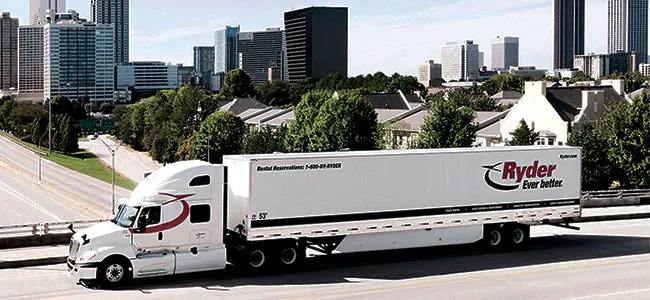Special to Transport Topics
Fleets Weigh Pay, Balanced Lifestyle to Retain Truck Drivers

[Stay on top of transportation news: Get TTNews in your inbox.]
The labor shortage in the trucking industry continues, with the demand for drivers still outpacing job availability.
As the subject has been studied by the American Transportation Research Institute, the real challenge, Senior Vice President Dan Murray said, is not in LTL, courier or even shorthaul.
“The biggest issue is longhaul trucking; that is where it’s really hard,” he said.
That’s why more shorthaul routes could play a role in boosting the workforce.
Shorthaul Trend
In recent years, trucking has trended toward a greater emphasis on short hauls. Although there is no standard industry definition of what constitutes a short haul, the primary idea is that it allows the driver to return home each night, or at least most nights.
“Everyone has their own definition. I would say that most fleets we talk to are going to say ‘regional’ is work that gets you home a couple of times a week,” said Mark Murrell, president of CarriersEdge, an online safety training business. CarriersEdge also operates Best Fleets to Drive For, a program that evaluates workplaces in the industry.

Lawson
Abigail Lawson, senior director of talent acquisition at Ryder System Inc., said that “shorthaul” means different things to different people, but generally, it’s a “home-daily” position or a shorter regional run. She reported that more than 75% of Ryder’s open positions are home daily, while noting that has become a trend within the industry.
“Truck drivers used to be gone weeks and months at a time — you don’t see that much anymore, except maybe independent owners, but it all comes down to people just wanting to be home more,” she said, adding that COVID-19 accelerated the shorthaul trend.
Ryder System ranks No. 6 on the Transport Topics Top 100 list of the largest for-hire carriers in North America.
Murrell agreed that the gravitation toward shorthaul has been ongoing.
“The ‘why’ is easy — no one wants to be on the road forever. Fleets are trying to do the right things for drivers, who do not always want to be on the road five, six days every week,” he said. We ask fleets if they look at why drivers leave. The No. 1 reason is to go to a local job, [so they] don’t have to be out on the road as often.”

Bratcher
Southern Glazer’s distributes alcoholic beverages and ranks No. 49 on the TT Top 100 list of the largest private carriers in North America. Due to federal regulations, the company must operate distribution centers and deliver orders within the same state. Mike Bratcher, regional vice president of operations, acknowledged shorthaul as being a general trend.
“I believe we have seen and will continue to see a shift toward shorter routes,” he said. “Recruiting quality drivers remains challenging, and companies are seeking competitive advantages to differentiate themselves. Short routes can be that draw to bring new drivers into the profession.”
Time Saving Strategies
Not all fleets have the ability to offer their drivers shorthaul routes. In those situations, some offer a different incentive that has similar attributes to shorthaul: a relay system in which multiple drivers on the same job swap trailers at a designated meeting point.
For example, CarriersEdge’s Murrell said, instead of a six-day trip, a load is broken up into segments, or relayed and handed off to another driver. That allows the original driver to return home more frequently.
The role of dashcams is evolving! In a recent Transport Topics article, CarriersEdge President Mark Murrell explains how fleets now use video for real-time coaching, risk prevention, and safety wins. Read more now! https://t.co/Oz5z3nBY51#DashCams #LevelUpYourDriverTraning — CarriersEdge (@CarriersEdge) January 29, 2025
Ryder has a similar operation, Lawson noted.
“If we have an ‘away from home’ job for a week, we will look and see if there are possible relays we can set up, with a driver based in the middle, so there can be more home time for both,” she said, adding for this to work a company needs to have enough drivers and equipment. However, some fleets look to this potential solution as a way to be flexible and promote driver satisfaction.
ATRI’s Murray noted that some companies also are employing a “drop and hook” strategy in which a driver will drop off a loaded trailer at a designated point without waiting for the cargo to be unloaded, resulting in less downtime for the trucker.
Recruitment Impact
There is debate as to whether the availability of shorthauls influences fleets’ ability to recruit new drivers. In Bratcher’s opinion, “It certainly acts as a gateway to attract millennials and Gen Zers to consider commercial driving as a career.”
But others say that while shorthaul is appealing because of the ability to make it home more frequently, the downside for some employees is the lower compensation. Also, for those fleets that offer shorthauls, or even the opportunity to switch from a longhaul route to a shorter route, companies may prioritize senior drivers to take those jobs, especially if an established driver is getting burned out by the road.

Murrell
“Can they offer it to new recruits? They can, but it’s delicate because how many do they have that won’t be taken up by existing staff?” said CarriersEdge’s Murrell. He noted that most current recruiting ads often generic and focus on what and where they transport rather than how long a driver is on the road.
Perhaps the outside perception is that truck drivers are gone for weeks on end, but there are options for different lengths of haul. Advertising or marketing the existence of shorter-haul runs, even if those jobs may not be available at the beginning of one’s employment, could help dispel that myth. Murrell said that could allow more potential employees to consider the industry when they might not have in the past.
Murray agreed that one of the biggest plugs for trucking companies to recruit new drivers is getting the message out about the frequency of when drivers get home.
“There is no question that the more a carrier can market getting drivers home more often,” he said, “the more successful they will be on the recruitment side.”
Ryder’s Lawson believes that this shorthaul trend positively impacts fleets’ ability to recruit new drivers and that it is a sought-after incentive, despite the lower pay. In recruitment, new hires want to know how often they will be on the road, and how much money they will make.

Ryder's Lawson says 75% of the carrier's open positions are “home daily” or shorter, regional haul routes. (Ryder System Inc.)
“Depending on the person,” she said, “those priorities can be flip-flopped.”
Companies that are exclusively shorthaul may have a competitive advantage for new drivers, Bratcher noted, adding that a number of drivers at Southern Glazer’s had left previous longhaul positions.
“Southern Glazer’s drivers are home every day, which is very attractive to drivers evaluating offers,” he said. “As more companies pivot to shorter routes, drivers have more choices.”
Balancing Expectations
Although longhaul driving may have more earning potential, the choice between money and lifestyle is daunting for those wanting to enter a profession that is perceived as all-consuming .
Lawson said that the primary demographic of drivers more interested in the shorter hauls are the new hires, particularly younger drivers who may not yet have a family and want to earn as much as possible at the start of their careers.
“The older generation of drivers are used to longhauls and are used to making more money. It is hard to take a cut in pay,” she said. “Some are willing to do it if they need more home time; they are OK with the trade-off. For the majority, it is harder.”

"Companies are seeking competitive advantages to differentiate themselves. Short routes can be that draw to bring new drivers into the profession," Southern Glazer's Mike Bratcher says. (Southern Glazer's)
Recruitment is only one piece of the puzzle. A carrier can hire all it wants, but if the turnover rate is excessive, then recruitment efforts are all but null. Balancing recruitment and retention may be the heart of the solution, with driver satisfaction being the root of it all.
Whether it’s the choice of shorthaul or longhaul, it depends on who’s entering or exiting the profession.
Transport Topics
“People get to a certain age and burn out. Maybe they are doing longhaul for a decade and are at the point where they are gone too much, and it is too hard on the back and body,” said CarriersEdge’s Murrell, adding that shorter runs should be used to keep seasoned drivers rather than to bring new drivers to the industry. “Fleets are recruiting. Why? Because of turnover. If they can cut some of that turnover by offering a better range of job options and more home time, they can keep people around longer.”
Ryder’s Lawson said, “Even if drivers prefer the longer hauls, they only want that for so long. It is rare someone that wants to do longer hauls for the long term.”
Impact of Shorthaul on Bolstering the Workforce
ATRI’s Murray explained that drivers’ perception of shorthaul and longhaul will differ because every new generation has pretty dramatic expectations.

Murray
“Gen Z is not interested in 12-hour days,” he said. “It is hard to know how far we can go with this movement to address shortage with shorthaul because a new generation will make us recalibrate.”
Murrell noted that the industry will reach a point where it will become standard operating.
“For the retention side, it gives you more business stability if a longhaul customer cancels or you lose a contract,” he explained. ”If you have different types of freight, you can survive. It will become standardized. You’ll still have some niche operators that only do one thing, but we are headed toward this being a standard way of operating.”
Want more news? Listen to today's daily briefing below or go here for more info:




